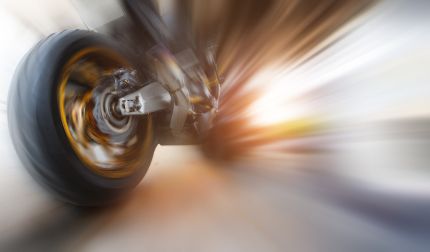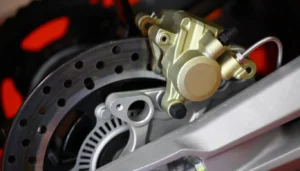Motorcycle speed wobbles, also known as “tank slappers,” are terrifying and dangerous. When the motorcycle’s front wheel oscillates or shakes violently, the rider loses control. Road conditions, rider input, and equipment condition can cause it at high speeds.
Riders must understand and address speed wobbles because they can quickly escalate and cause accidents, even fatal ones. Speed wobbles can endanger riders and other drivers, making them a major road safety issue.
Motorcycle speed wobbles’ causes and mechanics will be examined in this article. We’ll discuss prevention and regaining control after a speed wobble. Riders can improve their road safety and handle speed wobbles better by understanding their dynamics.
What Are Motorcycle Speed Wobbles?
“Tank slappers” are rapid, uncontrolled handlebar movements on motorcycles. Tank slapper refers to extreme handlebar oscillations that hit the bike’s fuel tank. These oscillations can start slowly but quickly escalate and cause a crash if not corrected. Speed wobbles cause violent shaking of the front wheel and handlebars, difficulty steering, and a feeling of instability or loss of control.
Common Speed Wobbles
Speed wobbles are most common when riding fast. They can be caused by road conditions (like hitting a bump or pothole), sudden manoeuvres (like quick turns or braking), bike modifications that affect balance, and motorcycle suspension or tyre wear. Unbalanced cargo can also cause speed wobbles.
Speed Wobble Physics
Speed wobbles involve many motorcycle design and dynamics factors. These result from high-speed forces and torques. Gyroscopic forces stabilise a moving motorcycle. If a pothole disrupts this balance, the front wheel may deflect to one side.
Due to the bike’s forward momentum, the restoring forces overshoot and swing the wheel to the other side. This swaying can quickly become a wobble. Misalignments in the bike’s structure, worn parts, and weight distribution can increase this instability.
Causes of Motorcycle Speed Wobbles
Motorcycle speed wobbles, though terrifying, usually have a cause. Preventing and managing speed wobbles starts with understanding these triggers. Detailing some common causes:
1. Tire-Related Factors
Tire Pressure and Condition:
Correct tyre pressure is essential for motorcycle safety. Over- and under-inflation can cause unpredictable handling and stability issues. Over-inflation reduces the tire’s contact patch with the road, decreasing traction and making it more likely to bounce over road imperfections. Under-inflation, on the other hand, can cause tyre deformation and instability. Tires with structural weaknesses, cuts, or bulges due to damage or age are also more likely to wobble.
Tire Tread and Alignment:
Tire tread should wear evenly for stability and handling. Uneven tyre wear can cause a wobble. Unaligned tyres can also cause handling and control issues, making wobbles more likely.
2. Suspension-Related Factors
Suspension Setup and Adjustments:
Motorcycle suspensions absorb road shocks, maintain tyre contact and predict handling. However, if the suspension isn’t set up properly for the rider’s weight, road condition, or riding style, road imperfections may cause a speed wobble.
Damaged or Worn-Out Suspension Components:
Wear and tear can degrade components. Speed wobbles can result from a suspension’s inability to respond to road or rider input due to a leaky fork seal, worn bushings, or sagging springs.
3. Aerodynamic Factors
Wind Gusts and Their Effect on Stability:
Motorcycles are wind-sensitive. A strong sidewind can blow the motorcycle off course. The rider may wobble if they aggressively steer to correct the path.
Body Positioning and Wind Resistance:
Rider body position affects motorcycle centre of gravity and aerodynamics. Sitting too far back or standing on the pegs at high speeds can make the bike top-heavy and unstable.
4. Mechanical Factors
Loose or Improperly Adjusted Steering Head Bearings:
Steering head bearings smooth the handlebars and front wheel. Loose or misaligned bearings can cause the front end to wobble.
Wheel Bearing Issues and Misalignment:
Wheel bearings smooth rotation. Worn bearings can cause wheel instability. Misaligned wheels, whether from setup or a collision, can cause handling issues and speed wobbles.
How To Fix Motorcycle Speed Wobbles?
Fixing motorcycle speed wobbles typically involves identifying and addressing the cause. Here are some general steps to follow:
- Inspect Tires and Wheels: Start by inspecting the condition of your tires. Look for any signs of excessive wear, uneven tread, or damage. Check your motorcycle tyre pressure. Also, verify that your wheels are properly balanced and aligned.
- Check Suspension Setup: Ensure your suspension is correctly set up for your weight and the type of riding you do. An incorrect suspension setup can make your motorcycle unstable, especially at high speeds.
- Examine Steering Components: Inspect the steering head bearings, as loose or improperly adjusted bearings can lead to wobbles. Make sure these components are correctly tightened and in good condition.
- Look for Mechanical Issues: Check for misaligned wheels, worn wheel bearings and frame or fork damage.
- Consider Aerodynamics: If you’ve recently added a new fairing, windscreen, or luggage to your motorcycle, consider whether these additions might be impacting the bike’s aerodynamics. In some cases, these changes can cause instability.
- Consult a Professional: If you’re unable to identify the cause of the speed wobble yourself, consider taking your motorcycle to a professional mechanic. They can diagnose and fix it.
Remember, prevention is always the best remedy. Regular maintenance and inspections, along with safe riding practices, can help prevent speed wobbles from occurring in the first place.
Signs and Symptoms of Speed Wobbles
A speed wobble’s main symptom is a violent oscillation of the motorcycle’s handlebars and front wheel. This oscillation starts slowly but intensifies quickly. The bike may feel unstable and the rider may lose steering control. “Tank slappers” are motorcycles with severe wobbles that cause the handlebars to hit the tank.
Speed Wobbles from Other Handling Issues
Speed wobbles must be distinguished from other handling issues to be effectively addressed. These are fast, violent, and often escalating. In contrast, a general handling issue like a consistent pull to one side or an overall sense of instability may indicate misalignment, tyre issues or a poorly adjusted suspension. Many handling issues can be observed regardless of speed or incident, but a speed wobble tends to occur at higher speeds and often follows an abrupt change, like hitting a pothole or making a quick manoeuvre.
Importance of Maintaining Situational Awareness
Speed wobbles require situational awareness. Riders must be aware of their motorcycle, road, and surroundings. Recognizing early wobble signs can prevent it from worsening. To detect abnormalities, you must be aware of the motorcycle’s normal behaviour. Regular checks on tyre conditions, suspension setup, and other mechanical factors help identify potential issues before they cause speed wobbles.
What Is a Death Wobble?
“Death Wobble” is a term used in the automotive world, especially by off-roaders, to describe extreme steering oscillation. Jeep Wranglers and older Ford and Dodge trucks with solid front axles are most likely to experience it.
The front wheels and steering components violently shake after hitting a bump, pothole, or other road imperfections at high speed. The “death wobble” is so named because the shaking can make the vehicle hard to control.
Death wobble is usually caused by loose or worn steering or suspension components that compromise vehicle stability. The steering box, track bar, control arms, ball joints and tie rod ends are examples.
This issue can also be caused by improperly balanced or installed tyres or misaligned wheels. The front axle can become unstable if the vehicle is overloaded, especially in the back.
If the driver slows down and avoids sudden braking or steering, death wobble rarely causes a crash. Preventing death wobble requires regular steering and suspension inspection and maintenance, as well as proper tyre balance and alignment.
How To Avoid Death Wobble of A Motorcycle
Motorcycle “Death Wobble” or “Speed Wobble” is a dangerous front wheel and handlebar oscillation at high speeds. Tire condition, aerodynamics, suspension setup, and mechanical issues can cause it. Preventing a motorcycle speed wobble involves several steps:
- Tire Maintenance: Make sure your motorcycle’s tyre pressure is within the manufacturer’s range. Tire wear should be checked and replaced. Wheels should be balanced and aligned.
- Suspension Setup: Check your suspension’s weight and riding style settings. If you frequently add passengers or heavy gear, adjust your suspension.
- Check Steering Components: Maintain your motorcycle’s steering head bearings. Tightening them prevents instability. Maintain your wheel bearings.
- Aerodynamic Stability: Body position can affect motorcycle stability. Maintain a forward-leaning position. When riding fast, wind gusts can affect your stability.
- Drive Smoothly: Avoid sudden speed or direction changes, especially at high speeds. Avoid potholes and bumps.
- Regular Maintenance and Inspection: Check your motorcycle’s parts regularly for damage. Brakes, suspension, tyres, and steering.
If the bike wobbles, ease off the throttle, don’t brake abruptly, and grip the tank with your knees to stabilise. Aggressive steering inputs can worsen the wobble. If your motorbike wobbles often, get it checked.
Conclusion
Motorcycle speed wobbles, also known as “death wobbles,” are a serious issue that riders should be aware of. Tire condition, suspension setup, aerodynamics, and mechanical issues can cause these violent and rapid oscillations of the motorcycle’s handlebars and front wheel.
Understanding speed wobbles’ causes, symptoms, and responses can reduce their risk and impact. Speed wobbles can be prevented by regular maintenance, proper alignment and tyre pressure, suspension adjustments, body positioning and controlled riding.
In the event of a wobble, stay calm, ease off the throttle, avoid abrupt braking, and don’t fight the wobble with aggressive steering inputs.
Knowledge, preparation, and preventative measures are the best ways to stay safe on the road and enjoy motorcycling.






